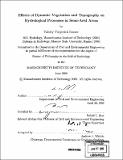Effects of dynamic vegetation and topography on hydrological processes in semi-arid areas
Author(s)
Ivanov, Valeri Yuryevich, 1974-
DownloadFull printable version (58.51Mb)
Other Contributors
Massachusetts Institute of Technology. Dept. of Civil and Environmental Engineering.
Advisor
Rafael L. Bras.
Terms of use
Metadata
Show full item recordAbstract
Ecosystems of dry climates represent a particularly interesting object for ecohydrological studies, as water is generally considered to be the key limiting resource. This work focuses on vegetation-water-energy dynamics occurring in the complex terrain of a semi-arid area characteristic of central New Mexico. The study constructs a dynamic model of coupled interactions, [tRIBS+VEGGIE], that considers essential water and energy processes over the river basin and links them to the basic plant life regulatory processes. After model calibration, a set of numerical experiments is carried out for two small-scale synthetic domains that exhibit characteristic hillslope curvatures. A weather generator is used to create the long-term series of meteorological forcing. The linkages between terrain attributes and patterns of C4 grass productivity and water balance components are examined for three generic soil types: sand, loam, and clay. It is argued that in conditions of negligible moisture exchange, site aspect and slope are the key determinants of both the hydrologic behavior and the degree of "favorability" to vegetation. (cont.) As shown, certain topographic locations are more favorable to vegetation development, as compared to a flat horizontal surface not affected by lateral effects such as radiative shading or water transfer. These locations are associated with sites of northerly aspect with surface slopes within a narrow range of magnitudes. Contributions from both the rainfall and radiation forcings are discussed to explain the existence of these niches. The sensitivity of results is investigated relative to modifications in the meteorological forcing and the dominant mechanism of lateral water transfer. The analysis unequivocally demonstrates the critical role of soil texture type in regulating the spatio-temporal aspects of coupling between vegetation-hydrology processes. Two additional controlling topographic features are suggested, corresponding to the local and global terrain convergence levels. Furthermore, it is argued that grass productivity and water fluxes of a site can be characterized as a function combining local and global terrain properties.
Description
Thesis (Ph. D.)--Massachusetts Institute of Technology, Dept. of Civil and Environmental Engineering, 2006. Includes bibliographical references (p. 425-453).
Date issued
2006Department
Massachusetts Institute of Technology. Department of Civil and Environmental EngineeringPublisher
Massachusetts Institute of Technology
Keywords
Civil and Environmental Engineering.